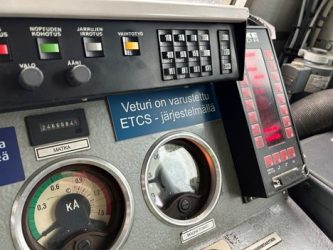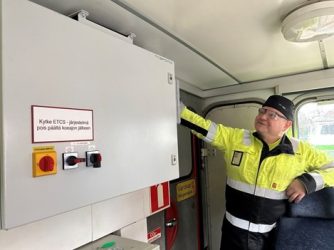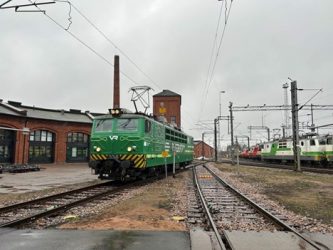Finland takes a leap towards ERTMS and FRMCS
Posted: 16 April 2024 | Peteveikko Lyly | No comments yet
Finland take an enormous leap towards European Rail Traffic Management Systems (ERTMS) and Future Rail Mobile Connection Systems (FRMCS).


The current train control system in Finland is expected to reach the end of its lifecycle around 2040. The ambition of the Digirail project – an inter-disciplinary team of experts with a mission to modernise the technical systems associated with train control on Finnish railways – is to seamlessly move to the European Railway Traffic Management System (ERTMS) and a modern radio based ETCS (European Train Control System). Current regulations make it mandatory for Finland, as an EU Member State, to update its systems and to exhibit interoperability with other next-generation European systems. The radio network will be based on the joint European FRMCS (Future Railway Mobile Communication System).
In 2023, as part of Finland’s work to update its systems in preparation for commercial traffic to begin in 2027 utilising the next-gen ERTMS, a test train project was initiated to connect a train with its OBU (on-board unit) to prove that a locomotive could reliably move, obey commands and contain the necessary built in safety measures. In late 2023, and ongoing in 2024, the work progressed to testing and measurement in a real-world scenario.
The 2023 test train project was named ‘KoKoHa’ after the Kouvola–Kotka–Hamina test track section set up in southern Finland. The precise goal was two-fold: to use the system version 2.1 OBU with GPRS (general packet radio service), with GPRS the standard service currently installed throughout Europe, and to prove that the “best effort” variant of FRMCS also works with OBU 2.1.
Aapo Tiilikainen, KoKoHa Project Manager at the FTIA, has worked on the project since its inception. Says Tiilikainen, “I was very worried that the planned system version 3.0 was going to be late and not fit into our time schedule. So, it was decided in Finland that we go with the software system version 2.1. But then there was the problem that this would not work smoothly with Internet Protocol (IP) traffic, which the future FRMCS will be based on.”
The view of the project team was that utilising 2.1 would be a much simpler and – when needed in 2027, due to the Digirail project implementation time schedule – the only available solution than the European-wide standardisation body is intending to specify for the future.
The ETCS installation work was carried out on Sr1, an almost 50-year-old locomotive, and was fitted with modern, radio-network-based ETCS train control equipment. With the new transducers, radars and sensors installed on the test train, the ETCS train control equipment was supplied by Thales Group Ground Transportation Systems (disclosure: Hitachi Rail was given clearance to proceed with its €1,660 million acquisition of Thales’ Ground Transportation Systems business on 30 October 2023).
Says Tiilikainen, “I would like to emphasise the teamwork here and the way the system provider (Thales) and we as the buyer successfully worked together and formed a project structure. This allowed us to cooperate on our objective and move forward with the implementation after we had discussed all the potential future obstacles.”
Adds Robert Richter, System Architect, Thales, “When the KokoHa project was in the pre-phase, we already had the standardisation for ETCS over GPRS. Through an earlier project in Denmark, I already knew quite well the technical stack, and the idea of the GPRS and TSI (Technical Specifications for Interoperability) so that when I visited the FTIA in Helsinki, I said ‘okay, we can do it, it’s not a problem to do your network with minimum changes to our stack’.”


The sign reads, “This engine is equipped with ETCS.”
A technical description of the setup
The test locomotive has been designed to communicate with safety systems via commercial radio networks. Elsewhere in Europe, GSM-R (Global System for Mobile Communications – Railway) networks have been used and are radio networks built specifically for traffic control.
The modification from GPRS to an LTE (Long Term Evolution) router (or 4G router) was not a huge modification and the software is based on the customer (Thales) delivery software.
Nicolae Boboc, Radio Engineer, Thales, believes it was a wise decision to not install a parallel infrastructure just for the communication of the trains track side with the OBU, but to use the commercial infrastructure. Says Boboc, “It is basically packet-based or IP communication. Previously, the track side was identified by a phone number and now it is identified by a name, which is then resolved by the domain name servers (DNS). So, we had to configure the domain name server to connect to it and then we get back an IP address and we have a communication via the IP. Of course, part of the communication connection was already developed. We had the packet base communication before but not exactly in this form.”
Adds Richter, “The RBC (Radio Block Centre) had no need to change at all. For the OBU, we just exchanged the direct usage of the mobile terminals and put the data in an IP packet and sent this IP packet to the customer (FTIA) provided router. To address the RBC, we now use DNS name resolving according to European-wide TSI standards instead of telephone numbers.”
Boboc notes that the changes did not affect the functionality of the signalling, but they were limited in the part of the communication connection. Regarding the future stability of the solution he says, “we observed pretty low latency of the network and while we currently have only one locomotive and one OBU connected, we are optimistic that it can be also used in commercial traffic in the future.”


Ilpo Lavonen was involved in the installation of the ETCS on-board unit (OBU) on the Sr1 test locomotive
KoKoHa train and OBU testing
The testing of the train on the approximately 43 km long KoKoHa track began on 10 November 2023, and the commissioning inspections ensure that the system operates in accordance with the requirements and that it is safe.
“The project is ongoing, but at the end of February 2024, the train had completed hundreds of kilometres of testing. This is the part where we ensure that the system, particularly from a radio point of view, works according to what has been ordered. The results to date indicate that the system works and seems to be stable,” says Tiilikainen.
The radio system replaces the current 2G GSM-R with 4G LTE, but with ETCS Level 2 and the train fitted with a modern OBU and 4G router, the team understands that this is currently unique in Europe.
The main target is to test the ETCS functionality. Notes Boboc, “But implicitly, we will also test the radio connection, because whenever we drive with the train, we need to have the radio connection established to be able to communicate between the OBU and the track side. So, the train is constantly reporting its position every three seconds to the track side. It’s receiving Movement Authorities (MA), and all this communication is done via the radio.”
Political and standardisation challenges ahead
For all the many successes on the project to date, EU-wide political and standardisation issues, which have led to delays, have also been an issue since the beginning.
KoKoHa is something between the legacy GSM-R based ETCS Level Two and the forthcoming FRMCS and the delays and uncertainty related to the stable version of FRMCS. So, these delays have now been identified as a problem, but our solution could resolve the delays. That said, our light version is not supported by the standard still under development because during 2019, the decision was taken to have a completely new system without backwards compatibility. So, the essential question is whether this working system has a place to live or whether people say that this light version is not meeting the goals and we have to keep on waiting for the completely new system.
It should also be noted that on 16 February 2024, the CTO (Chief Technology Officer) council asked the European Commission to enable an adapter to facilitate BL3 OBU communication with FRMCS because the currently planned FRMCS will not be compatible with previous versions. Therefore, there is now some pressure to enable the solution we have already implemented. And it’s a very positive thing for all of those countries who have OBUs in software system version 2.1 (BL 3.6) because you don’t have to invest in the system version 3.0 if you could use the slightly modified 2.1 with FRMCS, utilising the so called “best effort” mode of FRMCS.


The Sr1 test locomotive on the test track
To the future
In spring 2024, the team are keen to point out that what the project has demonstrated to date is only a working prototype on one test track, with just one train and one OBU. Of the results so far, says Boboc, “it’s a good pragmatic first step in the right direction, but there are still other steps to be done to make this a solution at country level and at continent level. From a technical point of view, I don’t see big obstacles are blocking points. But it’s also a matter of promoting the solution and making it both commercially viable and stable.”
At present, each European country gets to decide the moment they begin to start the transition away from 2G and towards 4G and 5G. Finland’s decision in 2015 was that it did not want to continue reinvesting in the 2G GSM-R solution for something which would soon be obsolete. But during this decade, many countries have continued investing in 2G GSM-R because the lifespan has been prolonged due of the delays of FRMCS. This latest real-world testing verifies that the Finnish two-step approach is doable, possibly even scalable in Europe and is, with small amendments, in accordance with the current regulations.
Concludes, Simon Indola, Development Manager, FRMCS, Digirail, “By utilising mobile network operators, we can show that you don’t have to buy your own antennas and base stations and you can use existing resources in a reliable way. Now, we seem to have a solution that might allow the railway operators to not to have to upgrade their ETCS from Level 2.1 to 3.0, but to continue to utilise their main investment into 2.1. My prediction is that what we have now achieved in Finland will be the winning solution across Europe in the future because the problems with the current standard and the future availability of equipment will push everyone to rethink FRMCS.”
For more information about Digirail, visit https://digirata.fi/en/
More Like This
OFF THE RAILS: Rail Baltic Estonia’s Environmental Expert Kati Saarem
“A call to arms”: how many women work in transport?
OFF THE RAILS: RIA’s Chief Executive Darren Caplan
Related topics
European Rail Traffic Management System (ERTMS), European Train Control System (ETCS), Future Railway Mobile Communications System (FRMCS)
Related organisations
Related people
Aapo Tiilikainen, Nicolae Boboc, Robert Richter, Simon Indola








